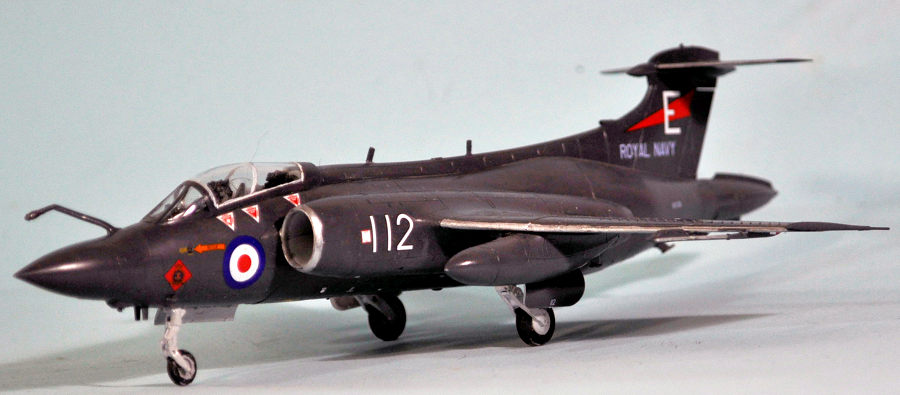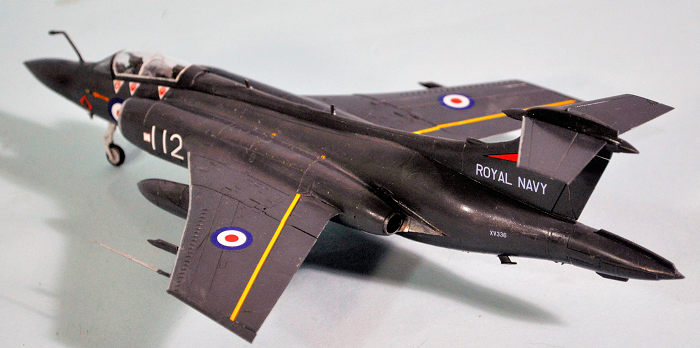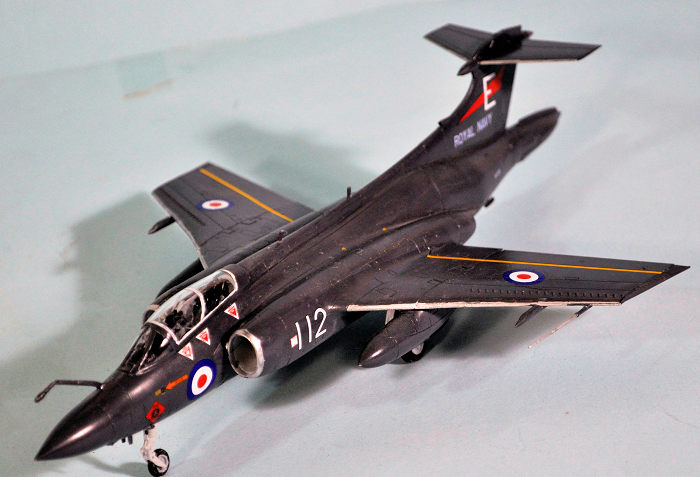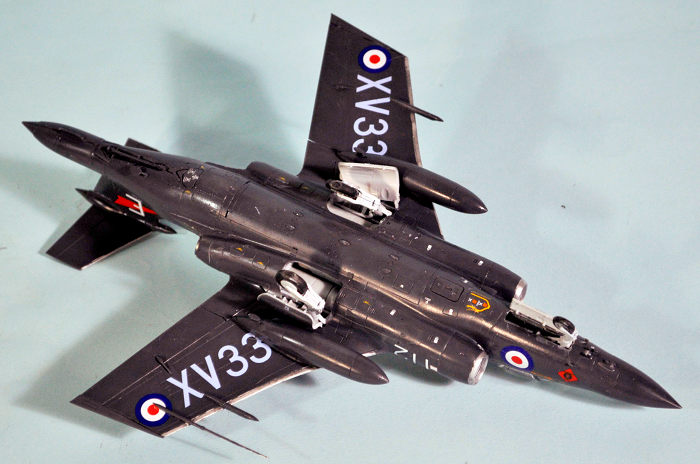
Airfix 1/72 Buccaneer S.2C
| KIT #: | A06021 |
| PRICE: | $35.00 |
| DECALS: | Two options |
| REVIEWER: | Tom Cleaver |
| NOTES: |

| HISTORY |
As the Cold War deepened, the Soviet Navy underwent expansion. The most important aspect of that in the 1950s was the Sverdlov-class cruiser; classed as light cruisers, they were fast and well-armed.Like the German "pocket battleships," they presented a serious threat to Western merchant fleets in the Atlantic. To counter the threat, the Royal Navy decided to develop a specialized strike aircraft that would opperate from the navy’s fleet carriers, capable of using either conventional or nuclear weapons and capable of attacking at high speed and low level.
Naval Staff Requirement NA.39, issued in June 1952, called for a
two-seat aircraft with folding wings, with a spe ed
of 630 mph at sea level, a combat radius of 400 nautical miles at low altitude,
and 800 nautical miles at high altitude. The aircraft was to be capable of
carrying A weapons load of 8,000 pounds, including conventional bombs, the Red
Beard free-fall nuclear bomb, or the Green Cheese anti-ship missile. The
Ministry of Supply issued specification M.148T in August 1952; first responses
were returned in February 1953. Blackburn's design by Barry P. Laight, Project
B-103, won the tender in July 1955. For reasons of secrecy, the aircraft was
called BNA (Blackburn Naval Aircraft) or BANA (Blackburn Advanced Naval
Aircraft) in documents, leading to the nickname of "Banana Jet". The prototype
N.A.39 made its first flight from RAE Bedford on April 30m 1958.
ed
of 630 mph at sea level, a combat radius of 400 nautical miles at low altitude,
and 800 nautical miles at high altitude. The aircraft was to be capable of
carrying A weapons load of 8,000 pounds, including conventional bombs, the Red
Beard free-fall nuclear bomb, or the Green Cheese anti-ship missile. The
Ministry of Supply issued specification M.148T in August 1952; first responses
were returned in February 1953. Blackburn's design by Barry P. Laight, Project
B-103, won the tender in July 1955. For reasons of secrecy, the aircraft was
called BNA (Blackburn Naval Aircraft) or BANA (Blackburn Advanced Naval
Aircraft) in documents, leading to the nickname of "Banana Jet". The prototype
N.A.39 made its first flight from RAE Bedford on April 30m 1958.
Given the emotive name “Buccaneer,” the Buccaneer S.1, entered squadron service with the Fleet Air Arm (FAA) in January 1963. The S.1 was powered by a pair of de Havilland Gyron Junior turbojets, producing 7,100 pounds of thrust, and was underpowered; It could not take off with full fuel tanks and armament. A temporary solution was the "buddy system," in which a Buccaneer took off with a full weapon load and minimum fuel, then would rendezvous with a Supermarine Scimitar and take on the full load of fuel by aerial refueling. The lack of power meant the loss of an engine during take-off, or landing at full load, when the aircraft was dependent on flap blowing, could be catastrophic, and the S.1 suffered a series of accidents due to insufficient engine power. The answer was an engine upgrade to the Rolls-Royce Spey turbofan, which provided a 40% increase in power, and the Buccaneer became the S.2C. The Spey was also more fuel efficient, which increased range. The S-2 was ordered into production in January 1962 and all FAA squadrons had re-equipped by 1966. With the new powerplant, the S.2C could launch at its maximum take-off weight.
 In
1962, the RAF put out a Request for Proposals for a new attack aircraft. The
Buccaneer was proposed but lost to the more advanced supersonic BAC TSR-2, which
was canceled due to cost. With the cancellation of its replacement, the General
Dynamics F-111K, the Buccaneer was finally picked up the RAF, entering service
in 1969 as the S.2B. Despite Blackburn being absorbed by Hawker-Siddeley in the
1960s and then Hawker-Siddeley becoming BAC, the Buccaneer has always been known
as a product of its original maker, and was in fact Blackburn’s last aircraft.
In
1962, the RAF put out a Request for Proposals for a new attack aircraft. The
Buccaneer was proposed but lost to the more advanced supersonic BAC TSR-2, which
was canceled due to cost. With the cancellation of its replacement, the General
Dynamics F-111K, the Buccaneer was finally picked up the RAF, entering service
in 1969 as the S.2B. Despite Blackburn being absorbed by Hawker-Siddeley in the
1960s and then Hawker-Siddeley becoming BAC, the Buccaneer has always been known
as a product of its original maker, and was in fact Blackburn’s last aircraft.
The Royal Navy retired HMS Ark Royal, the last of its large aircraft carriers, in 1978 and passed their Buccaneers to the RAF. A crash in 1980 revealed metal fatigue problems, resulting in the RAF fleet being cut to 60 aircraft, while the rest were scrapped. The Buccaneer finally took part in combat during the first Gulf War, where their low altitude strike capability saw them used to put Iraqi airfields out of operation. The end of the Cold War led to the RAF being reduced in strength, which accelerated retirement of the remaining aircraft, with the last Buccaneers in RAF service being retired in 1994, replaced by the Tornado. In South African Air Force (SAAF) service, Buccaneers also saw combat action in the South African Border War.
| THE KIT |
Airfix first released an N.A.39 Buccaneer S.1 around 1960-61. It was as primitive as most kits were at the time. I remember building one and not being particularly satisfied with it. Matchbox released a 1/72 S.2B in the 1970s, which was very little improvement in quality and detail. Airfix then released a 1/48 kit in 1991, which acquired a reputation as a putty monster.
 Airfix
announced a new Buccaneer in 2018, and it appeared in September 2019, to great
praise from Buccaneer enthusiasts. The kit is fully up to modern Airfix
standards, with 140 parts and decals for two FAA squadrons flying the aircraft
in the late 1960s-early 1970s.
Airfix
announced a new Buccaneer in 2018, and it appeared in September 2019, to great
praise from Buccaneer enthusiasts. The kit is fully up to modern Airfix
standards, with 140 parts and decals for two FAA squadrons flying the aircraft
in the late 1960s-early 1970s.
The kit has a very nicely-detailed cockpit for 1/72, and the two-part canopy is very thin and able to be mounted open. A full suite of weaponry is provided, and the rotating bomb bay door can be displayed open or closed. The split dive brakes at the extreme end of the fuselage can also be displayed open or closed with full detail if opened up. The wings can be assembled either folded or extended, and there are two different types of wing tip, so the S.2B can be modeled. Airfix has announced release of an S.2B later this year, but there are already aftermarket decals for Gulf War Buccaneers for those who cannot wait.
The kit is so successful that the first run sold out in a matter of weeks.
| CONSTRUCTION |
The best way to build a modern Airfix kit is to follow the very easily-followed instructions, which I did. I decided that I would build the model with the bomb bay and dive brakes closed, and would not hang ordnance underwing, while the wings would be assembled extended.
 After
painting the cockpit parts while still on the sprue, as well as the landing gear
and gear bays, I proceeded with assembly. The cockpit assembled easily and I
used the decals for the instrument panels. I painted the molded-on seat harness,
since I had decided to assemble the model with the canopy closed to preserve the
aircraft’s lines.
After
painting the cockpit parts while still on the sprue, as well as the landing gear
and gear bays, I proceeded with assembly. The cockpit assembled easily and I
used the decals for the instrument panels. I painted the molded-on seat harness,
since I had decided to assemble the model with the canopy closed to preserve the
aircraft’s lines.
After attaching the cockpit assembly to a fuselage half and then asssembling the center fuselage, I assembled the nose and set it aside. After attaching the rear fuselage parts and the wings, I filled the nose with crushed fishweights and test fitted to see if there was enough weight. It needed some extra weights in the fuselage ahead of the cockpit. With that, it was definitely a nose-sitter.
If you are careful to clean off all sprue nibs and are careful with assembly, you will not need any putty on this model and will only need to scrape down the fuselage centerline seam and the leading edges of the wings.
The instructions want you to assemble the full landing gear before proceeding to paint, but once I determined this wasn’t required for fit, I kept them off while I painted the model.
| COLORS & MARKINGS |
I masked the canopy, then painted it white, and then masked that off for the canopy seal (which should, in actuality be on the inside, but that’s more effort than I am willing to go to).
 The
model was painted with Tamiya “German Grey” as a good substitute for Extra Dark
Sea Grey, and I post-shaded by putting a brushful of white in the paint and
going back over the model. Masked the wings and tail and airbrushed the leading
edges with Vallejo Duraluminum, and hand-painted the engine intakes. When
complete, I gave the model an overall coat of clear gloss.
The
model was painted with Tamiya “German Grey” as a good substitute for Extra Dark
Sea Grey, and I post-shaded by putting a brushful of white in the paint and
going back over the model. Masked the wings and tail and airbrushed the leading
edges with Vallejo Duraluminum, and hand-painted the engine intakes. When
complete, I gave the model an overall coat of clear gloss.
The decals went on without problem, and I even managed to get on the majority of the very tiny servicing stencils. When the decals set up, I washed the model to get rid of setting solution residue and gave the model an overall coat of clear satin. I then painted the refueling probe tip with Vallejo Duraluminum.
I assembled the landing gear and attached them and the gear, and doors. I unmasked the canopy and declared the project complete.
| CONCLUSIONS |
Definitely the nicest Buccaneer kit ever released. There’s no putty monster problems, no fit problems, the details are certainly nice enough in 1/72. Anyone who follows the instructions with have a very nice result. One hopes Airfix will now replace that old 1/48 kit with a new release to the new standard. Recommended for all Buccaneer Buckos.
12 September 2019
Copyright ModelingMadness.com.
Thanks to Hornby USA for the review kit.
If you would like your product reviewed fairly and fairly quickly, please contact the editor or see other details in the Note to Contributors.
Back to the Main Page Back to the Review Index Page Back to the Previews Index Page